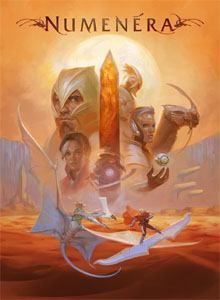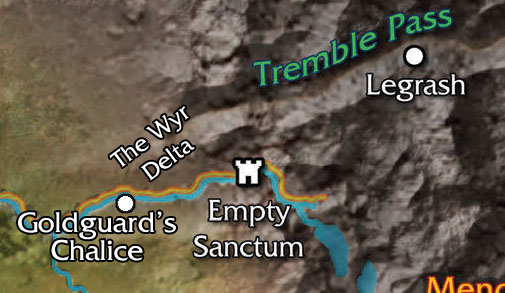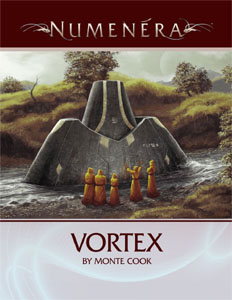 The Wandering Walk is a pilgrimage route through the Ninth World of Numenera. It is described, in part, on page 368 of the core rulebook:
The Wandering Walk is a pilgrimage route through the Ninth World of Numenera. It is described, in part, on page 368 of the core rulebook:
No one knows the exact length of the Wander, nor can anyone point to its exact beginning or end. Many people speculate that the Wander is actually a closed circle that encloses the whole of the Ninth World and that some travelers, especially those with enhancements or otherworldly attributes, have been trekking its eternal loop since before recorded time. (…)
Those who follow the Wander for religious, spiritual, or other reasons are called Peregrines or just Birds (though the latter term is usually derogatory). Although their dress varies, true Peregrines bear some mark of the Wander. Typically, the mark is an elaborate and continually growing circular bloodscar along their palm; there is little else to do along the Wander when one is not wandering, and the intricate nature of the scar gives bragging rights to show how long a traveler has survived along the way. Experienced Peregrines carry the scar up the length of their arm or on both palms.
Of course, there are also many who trek the Wander for other kinds of growth — namely the growth of their pockets. These skulkers who come to borrow from the bodies of the fallen often become inadvertent pilgrims themselves, either getting lost along the route or walking it to find a home where they can settle with their newfound spoils. They don’t generally make it far before they fall to the elements or to the hand of another skulker.
And thus the Wander captures all within its eternal length.
As described there, however, I don’t fully grok the Wandering Walk:
1. A pilgrimage suggests a visitation of sacred sites. What are these sites? Who are they sacred to? Why are they sacred?
2. The “route” has neither a beginning nor an end. It would follow logically, therefore, that anyone actually following the route would never revisit the same territory (unless we’re talking about semi-mythological immortals who might have completed a full loop around the entire world). Despite this, the rulebook seems to speak of common peregrines who are familiar with the route and able to avoid pitfalls through experience.
3. The full length of the “route” is unknown. How do peregrines follow it, then? Is it marked in some way?
In order to grok the walk, I decided to both expand it and rewrite chunks of it.
BLOODSCARS
Those traveling the Wandering Walk slowly develop a bloodscar — an elaborate and continually growing circular pattern of crimson that begins on their palms. Experienced peregrines will find that the scar extends up the length of their arms. Every peregrine’s scar is unique and there are some tellers who say that they can read the story of a walker in their scar, although whether there’s any real truth to that is hard to say.
What is certain, however, is that peregrines traveling the Walk can often tell which direction to follow by touching and meditating upon their bloodscar. The path of the bloodscar is, in fact, what determines the route of the Wandering Walk.
LORE OF THE WANDERING WALK
The path of the bloodscar is not always reliable, but various markers have also been left along the various stretches of the Walk.
The true lore of the Wandering Walk, however, comes from the fact that it is walked in both directions along its length. Thus declining peregrines (whose count of stretches descends from one number to the next) often encounter ascending peregrines (whose count of stretches ascends from one number to the next). Rumors, tales, and truths are passed freely back and forth: Thus a descending might learn of a roving band of skullhunters a few days further up the Walk from an ascending peregrine who avoided them himself, but heard the warning from a descending peregrine a year ago who had barely escaped from them.
THE FIFTH STRETCH OF THE WANDERING WALK
As described in the Numenera rulebook (pg. 370), the Fifth Stretch of the Wandering Walk begins at the mouth of Tremble Pass where it passes through the Black Riage and extends east to the Great Slab.
The length of the Fifth Stretch is marked by the Mouth Cairns: Hulking metallic structures which form shallow, circular hollows. These hollows are surrounded by short, round walls built from jaws of dead peregrines and are considered among the few safe places along the Fifth Stretch. Those who enter a bone circle must give some promise of their good intent to the slain lest the dead mouths awake and cast their retribution. Even those who don’t believe in the so-called Slaytongue may find themselves at the end of a weapon if they try to break the cairn-peace.
THE FOURTH STRETCH OF THE WANDERING WALK
The Fourth Stretch of the Walk is not described in the core rulebook and I do not know its ultimate origin (although I have heard both that it leads into the Sea of Secrets and that it passes through the Cloudcrystal Skyfields and into the lands of the Gaians beyond; perhaps there is truth in both).
What I do know is the ending of the Fourth Stretch: It leaves the kingdom of Thaemor and crosses the Wyr River at Goldguard’s Chalice.

Goldguard’s Chalice is named for Goldguard Langdon, who founded the nation of Thaemor, although it clearly predates Goldguard’s reign by untold aeons. The city at the base of the Chalice is often a place of respite for peregrines, who will rest and resupply there before plunging onward into the long, bleak leagues of the Fifth Stretch.
Beyond the Wyr River, the Wandering Walk turns north toward Tremble Pass and enters what is currently known as the “Wyr Delta”.

Unlike the straight and singular path which defines the rest of the Wandering Walk, this section of the Fourth Stretch splits apart into many different paths. Some of these paths follow rivers as they currently exist. Others follow dry riverbeds. Others simply pass through a harsh wilderness, but the hypothesis is that rivers used to run here; it was simply so long ago that any trace of them has been overgrown by the pine forests.
USING THE WANDERING WALK
The reason I, personally, decided to spend time etching into the lore of the Wandering Walk is that it provides a rather nice structure to hang scenario seeds off of. Specifically, I’m using it to launch the “playtesting” sessions of Numenera at my table.
First, establish that the PCs are ascending peregrines nearing the end of the Fourth Stretch of the Wandering Walk. The oddities of the Walk provide a nice dose of weirdness for introducing players to the setting; it also provides a loose bonding mechanism between the PCs that the players can improvise within while creating stories about when and how their characters met and why they’re traveling together. (The loose formality of the Walk also provides a nice mechanism for having players drop in and out of the sessions: If somebody can’t make it this week, it’s because they stayed behind or rushed ahead on their pilgrimage. And, of course, it’s just as easy for them to rejoin the group at a later date.)
 Second, I placed the Vortex adventure in the Wyr Delta. Thus the game begins with the PCs leaving Goldguard’s Chalice and, shortly thereafter, they encounter the scenario hook. The village of Jutte is located along one of the small tributaries leading down to the Wyr River. I placed the reappearance of the Narthex at a position 2 days ride north of Tremble Pass.
Second, I placed the Vortex adventure in the Wyr Delta. Thus the game begins with the PCs leaving Goldguard’s Chalice and, shortly thereafter, they encounter the scenario hook. The village of Jutte is located along one of the small tributaries leading down to the Wyr River. I placed the reappearance of the Narthex at a position 2 days ride north of Tremble Pass.
Third, once Vortex has been completed you can run “The Beale of Boregal” from the core rulebook (pg. 367). This adventure is already designed to lie along the Wandering Walk and takes place immediately on the other side of the Tremble Pass in the first reaches of the Fifth Stretch.
If you want to run additional adventures using this structure, it’s easy enough to seed the scenario hooks along the length of the Fifth Stretch. (And drop pertinent lore into the gathering of descending peregrines the PCs encounter in the Mouth Cairn at the beginning of “Beale”.)
 Some quick mechanical background for people unfamiliar with Numenera: In this system, you deal flat damage based on the type of weapon you use. (A light weapon does 2 points of damage; a medium weapon does 4 points of damage; and a heavy weapon does 6 points of damage.) You can increase the amount of damage you inflict by exerting effort or by rolling well on your attack roll. And, finally, you subtract the target’s armor value from the damage inflicted before applying it to their health pool.
Some quick mechanical background for people unfamiliar with Numenera: In this system, you deal flat damage based on the type of weapon you use. (A light weapon does 2 points of damage; a medium weapon does 4 points of damage; and a heavy weapon does 6 points of damage.) You can increase the amount of damage you inflict by exerting effort or by rolling well on your attack roll. And, finally, you subtract the target’s armor value from the damage inflicted before applying it to their health pool.
















